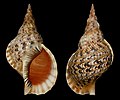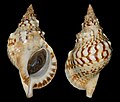Conchons
| Conchons | ||||||||||||
|---|---|---|---|---|---|---|---|---|---|---|---|---|

Charonia variegata , Crete , Greece (Mediterranean) |
||||||||||||
| Systematics | ||||||||||||
|
||||||||||||
| Scientific name | ||||||||||||
| Charonia | ||||||||||||
| Gistel , 1847 |
The Triton horns ( Charonia ) are a genus of snails from the Triton snail family , which is found in all tropical regions of the world's oceans. All three currently accepted species are very large and live on echinoderms .
features
The right -hand wound casings of the conch horns are trochospiral, i.e. not rolled up in one plane, but three-dimensionally. The thread is tapered, the thread circumference convex, the body circumference bulbous and takes up more than half the length of the housing. The mouth is egg-shaped, the mouth edges turned up. The front end is drawn into a very short siphon channel. The snail shells are typically creamy white in color with brown crescent-shaped spots. The operculum is egg-shaped.
The snails are brownish red to yellow or whitish with a reddish brown speckled pattern. The antennae are usually bright yellow and have two black rings.
All conch horns are separate sexes. The females lay numerous egg capsules, each of which can contain several thousand eggs. There are no eggs. The Veliger larvae go through a pelagic phase lasting several months , so that all three species have a large distribution area.
The conchons feed on echinoderms , especially starfish . Mollusks and crabs are also preyed on . The salivary glands produce free sulfuric acid , with the help of which the prey is paralyzed and its calcareous skeleton is softened.
Danger
All conch horns are collected because of their imposing casings, so that humans can be considered a main enemy. The populations of both species in the Mediterranean are protected under the Federal Species Protection Ordinance ( Appendix 1 ) and the Bern Convention . However, in terms of global risk, they are not included in the Red List.
Systematics
According to WoRMS , three described species are currently recognized as such: The conch ( Charonia tritonis ) living in the Indo-Pacific , the Atlantic triton snail ( Charonia variegata ) in the Atlantic and Mediterranean, and the knot-bearing triton snail ( Charonia lampas ) in the Atlantic and Mediterranean and with smaller occurrences in the Pacific .
A total of at least 15 Charonia species have been described, the majority of which are now regarded as synonyms or as subspecies. Type species is Charonia tritonis , described by Linnaeus as Murex tritonis . Synonyms of the generic name, which are found more often in older literature, include Triton Montfort , 1810 and Tritonium Röding , 1798.
Conch ( Charonia tritonis )
Atlantic triton snail ( Charonia variegata )
Knot-bearing triton snail ( Charonia lampas )
literature
- Betty Jean Piech: Ranellidae and Personidae: A Classification of Recent Species. Delaware Museum of Natural History, Wilmington Del. 1995, OCLC 33600855 .
- Frank Riedel: Origin and evolution of the "higher" Caenogastropoda. Berliner Geoscientific Abhandlungen, Series E, Volume 32, Berlin 2000, 240 pages, ISBN 3-89582-077-6 .
Individual evidence
- ^ World Register of Marine Species , World Marine Mollusca database: Charonia Gistl, 1847
- ↑ In Appendix 1 to § 1 of the Federal Species Protection Ordinance , the triton horns are listed under the names Charonia tritonis ("only populations of the Mediterranean", thus subspecies Charonia tritonis variegata ) and Charonia rubicunda , which, according to WoRMS, are synonyms for Charonia variegata and Charonia lampas .
- ↑ mare-mundi.eu: Facts (invertebrates) - Family Ranellidae (formerly Cymatiidae), Triton snails


